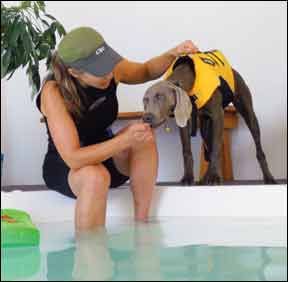Splish splash! These dogs aren’t takin’ a bath; they’re working out in pools large and small to get in shape, stay active, or recover from accidents, illness, or surgery. Whether swimming breeds or those that prefer to keep their feet dry, dogs of all ages have gotten stronger, decreased lameness, loosened tight muscles, increased coordination, improved balance, hastened healing, and increased stamina and flexibility with hydrotherapy.
Photo by Carol Helfer
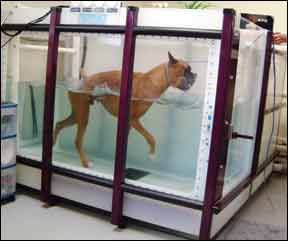
Because of its effectiveness, hydrotherapy, or water exercise, has become popular at veterinary clinics and canine rehabilitation centers. The first hydrotherapy equipment was built for horses and racing Greyhounds, but the treatment is now available to dogs and cats in the United States, Canada, Japan, Western Europe, and the United Kingdom. Typically performed in a swimming pool or a plexiglass chamber holding an underwater treadmill, hydrotherapy stimulates the cardiovascular and lymph systems, strengthens muscles, and allows painful joints to move comfortably.
Hydrotherapy works because water makes exercise weightless. Swimming or walking in water exercises joints and muscles without the jarring effects of gravity and hard surfaces. Many patients with arthritis, hip or elbow dysplasia, joint pain, cruciate ligament ruptures, and bone fractures have made significant improvements thanks to water exercise. So have patients with neurological disorders such as degenerative myelopathy or problems caused by spinal strokes. A spinal stroke or fibrocartilaginous embolism (FCE) occurs when an obstruction or clot blocks the spinal cord’s blood supply, resulting in a loss of mobility.
In October 2010, Gracie, a nine-year-old Dalmatian who lives with Jeanne Stehno in Great Falls, Montana, suffered a painful back injury and underwent a hemilaminectomy, in which herniated disc material was removed from beneath her spinal cord. Manipulation of the spinal cord can produce neurological symptoms, and after surgery, Gracie’s hind legs dragged and she couldn’t walk. She was able to use a cart, but Stehno hoped for a more complete recovery.
At the animal hospital where Stehno works as a receptionist, an emergency veterinarian recommended Certified Canine Rehabilitation Practitioner Jennifer Hill in Helena, Montana, 90 miles away. Beginning in January 2011, Gracie and Stehno made the trip every 7 to 10 days for hydrotherapy.
“Gracie is not a fan of swimming,” says Stehno, “but the minute she got in the water, her legs began moving. By June, when she took her last swim, Gracie had learned to walk again and her legs were strong. She can go up and down stairs on her own, and while she still has occasional moments of being unsteady on her feet, it is exciting to take her for walks and admire her improvement.”
Underwater Treadmills for Dogs
In Portland, Oregon, veterinarian Carol Helfer, DVM, has offered hydrotherapy at her Canine Peak Performance Sports Medicine & Physical Rehabilitation Center for almost a decade.
“Because of our limited space,” she says, “we use an underwater treadmill. Most dogs use their front limbs significantly more than their rear limbs while swimming, and since I see far more problems with the rear limbs, walking on an underwater treadmill is an effective therapy for most patients.”
At the beginning of a treadmill session, the dog enters an empty plexiglass chamber by taking a shallow step up. The speed is set to accommodate the dog’s size and condition. Warm water (usually 80 to 88 degrees Fahrenheit, approximately 27 to 31 degrees Celsius) enters the chamber and the dog is soon walking in water. The level is adjusted to whatever the dog requires, such as shoulder-high for extra buoyancy after surgery or to relieve joint pain, or knee-high for a more vigorous workout.
Some underwater treadmill systems include adjustable hydrotherapy water jets, a reversible treadmill, or adjustable ramp angles that alter weight distribution or target specific muscles.
“Most dogs start out with one to three exercise sets, each lasting two to three minutes, depending on how they tolerate the activity,” says Dr. Helfer. “In most cases my goal is to get them up to 20 minutes of continuous walking. The time it takes to get there varies widely depending on the age and condition of the dog. I start patients at 0.3 miles per hour (MPH) and seldom get above 1 MPH. On occasion I’ll work with a dog specifically for athletic conditioning, in which case I may use speeds of 3 to 5 MPH.”
Dr. Helfer has exercised tiny Yorkshire Terriers and super tall Irish Wolfhounds on her treadmill, and no dogs have been too big or too small.
Therapeutic Pools for Dogs
Hydrotherapy pools can be anything from large or small swimming pools to endless-lap pools in which continuously moving water creates resistance. Except for healthy, experienced dogs swimming for recreation or general conditioning, patients wear life vests. In some hydrotherapy pools, swimming dogs are supported and directed by overhead wires attached to their vests.
DVM.
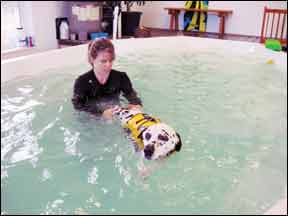
When Apex Animal Hospital in Helena, Montana, was built last year, Jennifer Hill recommended installing a pool. “I am a licensed physical therapist and worked with human patients before I started working with dogs,” she says. “I spent my physical therapy internship in Hawaii, where I took aquatic therapy classes. I love being in the water with patients and like the flexibility that an endless pool provides. It’s wonderful for recreational swimmers, for targeted therapy, and for everything in between. The underwater bench at the edges of the pool and steps at the shallow end provide a stable surface for walking or standing. This is especially helpful for smaller dogs like Corgis and Dachshunds, which are the breeds most prone to back injuries. In addition, the pool’s adjustable water jets create a mild to strong current for swimming.”
Hill does more than help dogs swim in different directions. “If the hind legs are weak, which is often the case,” she says, “I present my hand as a target. Dogs appear to instinctively kick against whatever their feet touch. Active kicking is also good for the hips. If the front legs need work, I position my hands at the front feet. The harder I press against the paw pads, the harder the feet push away from my hand. I also tilt the dogs a little to the left or right, which shifts their center of gravity and creates an automatic adjustment.”
Hill lures swimming dogs with a tennis ball, toy, treat, or whatever they will follow so they turn left, turn right, and swim in figure 8s. “That’s so important for spinal motion,” she says. “Another thing I do for dogs with neurological damage from surgery or spinal strokes is pinch their toes in the rhythm of walking or swimming. Alternating and simultaneous rhythmic pinching establishes patterns that help treat ataxia, which is a gross lack of coordination.”
Some of Hill’s patients have taken advanced obedience or agility training. “It’s fun to work with a dog who responds to voice instructions,” she says. “You can say ‘left’ or ‘right’ and the dog will do her own figure-8s.”
Another option in pools is the use of a small floating platform, like a boogie board or miniature surfboard. “This works very well for small dogs,” says Hill, “and they get a serious core workout just keeping their balance. The board dips forward, back, left, and right, and for an added workout we turn on the white-water jets.”
Dogs recovering from surgery, illness, or injury at first require Hill’s hands-on attention, but as they grow stronger and more experienced, they can be supervised by a veterinary technician. “On swim days we live in our wet suits,” says Hill. “We’re in the water with the dogs and we encourage the owners to be right beside the pool so they can participate and see the progress their dogs make.”
As with underwater treadmills, the water temperature in hydrotherapy pools is typically 80 to 88 degrees Fahrenheit. Some facilities feature salt water, for which additional therapeutic claims are made. The term thalassotherapy refers to therapeutic baths in warm seawater, which is similar to the body’s own internal fluids and which is said to allow magnesium and potassium to be drawn into the blood stream while toxins are eliminated.
Typical Canine Hydrotherapy Patients
Because dogs take up hydrotherapy for many reasons, most facilities define categories of treatment depending on their condition and medical history.
For example, Apex Animal Hospital defines four levels of treatment. Level 1 patients are the most incapacitated, and require two experienced handlers. “We use two people for safety,” says Hill, “and that refers to our own safety as well as that of the dog. As soon as a surgical patient gets a go-ahead from his or her vet, we move to the water.
“One of my favorite Level 1 patients was a Bernese Mountain Dog who had just arrived at the hospital to have both knees operated on when he ruptured a shoulder muscle. The knee surgery went ahead as planned but the shoulder repair was done later. There were serious complications with one of the stifle surgeries, so we actually could only work on the shoulder. That was a two-person job! In other cases the patient may be so out of condition or obese that it takes two people to help the dog into and out of the pool. One Labrador Retriever weighed 187 pounds and had never been in water when he came for his first swim. He has trimmed down to 164 pounds and, while he still has a way to go, he no longer needs both of us in the pool with him.”
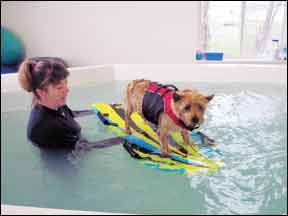
Most patients with knee or stifle injuries or surgery, hip surgery, or fracture repairs receive four weeks of dry land rehabilitation therapy from Hill before swimming.
At Apex, dogs stay at Level 1 or Level 2 (with just the rehabilitation therapist in the pool) for five weeks and are re-evaluated. Level 3 dogs are still recuperating but require less supervision, and Level 4 dogs swim for play, recreation, or general conditioning with a veterinary technician.
The goal at all levels is to improve muscle strength and stamina, provide a cardiovascular workout, stimulate lymph circulation, increase range of motion, and bring all sides of the body into balance by moving in all directions.
“My hydrotherapy patients fall into three categories,” says Dr. Helfer. “These are geriatric patients, dogs recovering from surgery or neurological problems, and those with soft-tissue injuries. I see the most dramatic results in the geriatrics. It is quite remarkable how much these patients improve with the right kind of exercise. Elderly dogs who had trouble jumping into the car or onto the sofa start doing these things again, and their stamina increases on walks. I’m not going to turn a 13-year-old into a puppy, but owners often comment that Fluffy is doing things she hasn’t done for years.”
One of Dr. Helfer’s favorite patients was Noah, a Newfoundland who started hydrotherapy sessions at age 12. “That’s a grand old age for a Newfie,” she says. “He was in pretty good shape for an old guy but was having some trouble getting around. He improved greatly with twice-a-week sessions and finally passed away at 15½. I’m convinced that the quality of the last years of his life greatly improved because of regular hydrotherapy.
“Noah was a typical geriatric. We started with multiple sets of a few minutes at a time and gradually worked up to 20 minutes of exercise without a rest break. As far as I know, the hydrotherapy was the only exercise he got other than short walks around his neighborhood.”
The most common surgical patients Dr. Helfer sees have had knee surgery, usually for cruciate ligament tears or luxating patellas. “Dogs recovering from spinal surgery also benefit greatly,” she says.
Soft-tissue injuries respond more slowly to treadmill hydrotherapy, says Dr. Helfer. These injuries to muscles, tendons, and ligaments often result from slips, falls, or sprains. “Sometimes in the later stages of recovery I will use treadmill hydrotherapy for a very controlled return to activity,” she says. “I lay out a specific schedule of activities over a period of six to eight weeks. The biggest mistake I see people make with cases of soft-tissue injury is to rush things. Since dogs are usually eager to get back to being active, you can’t depend on them ‘telling’ you that one activity or another is difficult or painful. A few minutes too much of the wrong type of activity can set progress back for weeks.”
Hydrotherapy Isn’t for Everyone
Despite its exceptional benefits, hydrotherapy isn’t for every dog, such as dogs with cardiovascular issues, infected wounds, or a serious fear of water. A history of aggression can be a problem as well.
Just because a dog has never shown an interest in swimming doesn’t mean he or she won’t benefit. Many dogs have learned, with the help of a life vest and a good coach, that swimming can be fun. Dogs who are truly terrified of water because of a traumatic past event are better suited to land-based exercise.
Cost is another factor, for not every dog lover can afford hydrotherapy. Therapeutic swims or treadmill sessions with a veterinarian or Certified Canine Rehabilitation Practitioner (CCRP) – or a rehabilitation practitioner working with an assistant – cost more than recreational swim sessions. Most clinics charge different rates depending on the attention and treatment the patient requires. Therapeutic and recreational swim sessions may last 30 minutes or one hour. Fees vary by region and facility, with most offering discounts for packages of five or more swim sessions.
Long-Term Benefits of Hydrotherapy for Dogs
Although the evidence is anecdotal rather than from controlled clinical trials, veterinarians, rehabilitation practitioners, dog trainers, and owners agree that hydrotherapy can make a world of difference for dogs with physical problems.
Veterinary chiropractor Tia Nelson, DVM, of Helena, Montana, has noticed that dogs who take up hydrotherapy hold their chiropractic adjustments longer than they did prior to swimming. “This makes sense,” she says, “because swimming is a comfortable non-weight-bearing exercises that strengthens the body without stressing it. Swimming helps the body maintain its alignment.”
Dr. Helfer considers hydrotherapy an injury preventer. “The improvement in muscle strength and balance can save the day in a slip-and-fall situation,” she says, “or on an awkward landing in a jump.”
Older dogs who swim are often more active and agile than their non-swimming counterparts, and hydrotherapy has helped many dogs reach a ripe old age with energy and coordination.
“It’s excellent for post-op recovery,” says Jennifer Hill, “injury prevention, and general conditioning. Arthritic dogs become more active, dogs with hip or elbow dysplasia have an easier time climbing stairs, and some agility dogs and other dogs who compete in canine sports win or achieve their personal best after taking up hydrotherapy.”
Do-It-Yourself Dog Hydrotherapy
Dog lovers who have access to pools, lakes, the ocean, or other bodies of water can help their dogs stay active by taking them swimming.
Adele Delp, a veterinary technician and dog trainer, teaches puppy kindergarten classes in the hydrotherapy room at Apex Animal Hospital.
“I teach a six-week class that’s part of the American Kennel Club’s STAR puppy training,” she says. “STAR stands for Socialization, Training, Activity, and Responsible ownership. In addition to introducing puppies to basic behaviors like walking on a leash, greeting politely, and learning how to sit, I have them climb in and out of an empty shallow wading pool. The following week, the pool has an inch of water in it. The week after that, it’s a deeper wading pool, and a week later the deeper pool contains water. They also get used to wearing life vests. At the final session, they go one at a time into the pool with me and start swimming.”
The STAR-class puppies who love the water aren’t just Labs and Golden Retrievers. They’re as varied as Yorkies, Giant Schnauzers, Malamutes, Beagles, Chinese Cresteds, Weimaraners, and German Shepherd Dogs.
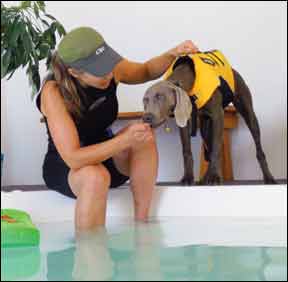
Delp does everything she can to make the experience positive. Puppies enter the water gradually and with lots of praise and rewards. This same approach can help your pup or older dog get used to swimming. If you live near a stream, lake, or river, look for a gradually sloping beach or bank that is smooth rather than muddy or rocky. Be sure the area is safe for dogs.
Having an easy way in and out helps dogs feel secure. If using a swimming pool, stay at the shallow end at first (dogs can’t climb vertical ladders), and through repetition teach your dog where the shallow end is. Keep the pool securely fenced off or covered when not in use.
Buy or borrow a canine life vest that fits securely and allows unrestricted front leg motion. A leash or line can be attached to the vest, but be sure your dog doesn’t become entangled.
In a river or stream, keep your dog away from currents. Don’t throw rocks for your dog because they break teeth so easily.
“My motto is get in and stay in,” says Hill. “Try to avoid running in and out of the water because it is often during these transitions that injuries happen.”
All dogs have a fatigue level and symptoms of fatigue include a tongue that drags, darkens, or curls up at the ends while the dog is panting; bloodshot whites of the eyes; or an obvious slowing down. Provide ample rest periods.
Guard against excessive sun exposure with sunblock on the dog’s nose.
For dogs who are recovering from accidents, illness, or surgery, be sure to wait for your veterinarian’s OK before swimming.
If your dog will chase a tennis ball or other toy in the water, toss it to encourage distance swimming and frequent turns. For every turn to the right, add a turn to the left, and aim for figure 8s to exercise the spine. If you’re in the water with your dog, use a tennis ball or other lure to create turns with a tighter radius. Also try tipping the dog slightly to one side, which strengthens the tipped side as the dog regains balance. You can also try the toe-pinching and foot-touching exercises mentioned by Jennifer Hill.
If your dog doesn’t take to the water right away, don’t be discouraged. “Our hydrotherapy patients often need three sessions before they catch on,” says Hill. “A typical example is Shadow, a five-year-old Border Collie who experienced a spinal stroke. Shadow did not like the water at all, and his first two sessions weren’t much fun. Then during his third session a light bulb went on in his head and he realized he could fetch a tennis ball. He can’t do this on land any more, but in the water he’s an athlete. Now when his owners ask if he wants to go for a swim, Shadow screams and howls, he’s so excited.”
When Chloe started her swim sessions last April, my husband wondered whether Seamus, his seven-year-old Cairn Terrier, would enjoy swimming, too. Seamus will probably never jump into water on his own, and his first two sessions produced moments of high anxiety, but by his third lesson he caught on and he is now a strong swimmer. Today, Seamus loves being on the boogie board and that’s his favorite target. His spine and tail are straighter, his stamina on hikes has increased, his hind legs are stronger, and he is able to jump from the ground onto my car’s back seat and from the floor onto the bed or sofa, which he wasn’t able to do without assistance before he took up swimming.
Rinse the Chlorine Off Your Dog
If your dog swims in chlorinated water, salt water, or swampy water, he’ll need a bath or at least a rinse afterward. Here are some favorite after-swim treatments:
Our article on Willard Water (WDJ June 2006) reviewed the many ways this concentrate can be used internally and topically to improve a dog’s health. Diluted at the rate of 1 teaspoon to 1 tablespoon concentrate per gallon of water and poured over the dog, Willard Water helps prevent dander, freshens the coat, and helps most dogs smell better. Willard Water concentrate can be added to shampoo or conditioner, but my favorite use after swimming is as a chlorine-destroying rinse. In 1991, shortly before his death at age 84, I corresponded with Dr. John Willard, who developed the formula, about its effect on chlorine. He confirmed that extensive laboratory testing proved that small amounts of Willard Water neutralize or destroy chlorine. In fact, he warned against adding Willard Water to any load of laundry using chlorine bleach. “The bleach won’t work,” he said.
Years ago, Colorado aromatherapist Frances Fitzgerald Cleveland was out of town when her dog, Jake, developed a hot spot. The steroid shot he received caused kidney failure and Jake died. In his memory, Cleveland blended Jake’s Canine Remedy, which contains purified water, apricot kernel oil, and a proprietary blend of essential oils. In our September 2006 article on hot spots, Cleveland described how Oscar, her black Labrador Retriever, swam every day, got sprayed every day, and never had skin problems. Jake’s Remedy has a pleasant, fresh, relaxing fragrance.
After her Willard Water rinse, Chloe gets sprayed with Jake’s Remedy, which I brush through her coat. For dogs prone to swim-related skin irritation under or next to the collar, Jake’s Remedy can be an effective preventive treatment.
Adele Delp’s favorite after-swim treatment is Sea Plasma All-purpose Skin and Hair Moisturizing Spray by Focus 21. Its key ingredient is Na-PCA, or sodium pyrrolidone carboxylic acid, a natural moisturizing factor in skin which is synthesized from glutamic acid, a non-essential amino acid.
“I dilute it at the rate of 1 part product to 10 parts water,” she says. “It isn’t a silky conditioner and it doesn’t make the coat shiny, but it penetrates the skin, helps keep the skin supple, reduces dander, and smells good.”
Jennifer Hill’s favorite after-swim rinse is chamomile-peppermint tea. Chamomile is a well-known skin soother that has a calming effect on dogs, which helps them relax and rest after workouts. It helps reduce skin irritations and is safe for sensitive skin. Peppermint’s fragrance is uplifting and refreshing. Mildly astringent, it heals abrasions, helps prevent hot spots, and is a natural skin toner.
To brew, pour 1 quart boiling water over 2 chamomile and 2 peppermint tea bags (available at supermarkets and natural food stores), cover, and let stand until cool. For a stronger solution, double the number of tea bags. One quart should be sufficient for small dogs. Brew up to 4 quarts (1 gallon) tea for large and giant breeds or for a more thorough application. Apply as a final rinse, work into the coat, and let dry. Because herbal tea can darken hair, it is not recommended for white dogs. Herbal tea rinses can be combined with Willard Water concentrate for increased effectiveness.
Freelance writer CJ Puotinen lives in Montana. She is the author of The Encyclopedia of Natural Pet Care and other books and a frequent contributor to WDJ.



